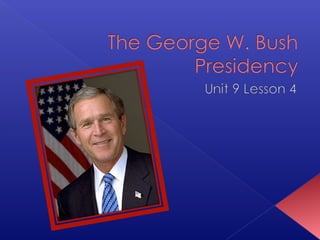
Unit 9 lesson 4 the george w. bush presidency
- 2. Objectives • Assess the outcome of the 2000 presidential election. • Explain the goals and achievements of George W. Bush’s domestic policy and important issues of Bush’s second term. • Analyze the impact of terrorist attacks on the United States.
- 3. Terms and People • No Child Left Behind Act –2002 law aimed at improving the performance of schools through mandated sanctions against schools not reaching federal performance standards • Patriot Act − a law passed after 9/11 that gave law enforcement broader powers in monitoring possible terrorist activities • Taliban – the Islamic fundamentalist faction that controlled most of Afghanistan from 1996-2001 • Weapons of Mass Destruction (WMD) − nuclear, biological, and chemical weapons intended to kill or harm on a large scale
- 4. What was the impact of Bush’s domestic agenda and his response to the terrorist attack against the United States? With the election of George W. Bush to the presidency in 2000, Republicans controlled the White House and Congress. When the United States was attacked by terrorists on September 11, 2001, Bush moved the nation in a new direction.
- 5. “All who live in tyranny and hopelessness In 2005, George W. Bush was can know: The sworn in as President for a United States will second term. In his not ignore your inaugural address, he oppression, or alluded to a remarkable excuse your shift in traditional American oppressors. foreign policy, saying that When you stand the cause of advancing for your liberty, freedom and democracy we will stand abroad was sufficient with you.” reason for the United States George W. Bush to involve itself in conflict Second Inaugural Address, 2005 overseas.
- 6. As Clinton’s second term neared its end in 2000, his Vice President, Al Gore, ran for the Democrats against Republican George W. Bush for President. Although Gore won more popular votes than Bush, the electoral vote margin was too close to call. The election depended on Florida’s 25 electoral votes.
- 7. Because the vote in Florida was so close, state law mandated an automatic recount. The Supreme Court case of Bush v. Gore ended the recount. Bush was declared President.
- 8. Bush pursued an aggressive conservative agenda when he took office. He passed a series of tax cuts. Bush promoted the 2002 No Child Left Behind Act to raise national academic standards. In 2003, despite criticism, Bush worked with Congress to extend Medicare to cover prescription drugs for seniors.
- 9. September 11, 2001 Then something happened that challenged the new President and led to a shift in U.S. foreign policy. On September 11, 2001, terrorists hijacked and crashed four airplanes. Two planes hit the World Trade Center in New York City. More than 3,000 people died as the twin towers collapsed. There was no remorse
- 10. In response, the United States began a “war on terror.” Bush first focused on the terrorists who perpetrated 9/11.
- 11. Osama bin Laden, leader of the al Qaeda network, was thought to be hiding in Afghanistan where the Taliban allowed him to operate. The United States and its allies sent forces to Afghanistan and overthrew the Taliban. Bin Laden escaped capture; Afghanistan held free elections and wrote a new constitution.
- 12. Bush worked to prevent future terrorist attacks with the passage of the Patriot Act and the creation of the Department of Homeland Security. Bush then turned his attention to Iraq, where many feared Saddam Hussein was stockpiling Weapons of Mass Destruction (WMD). In 2003, U.S. and British forces invaded Iraq.
- 13. Saddam and many of his supporters were captured, but many Americans were troubled by the war, terrorism, and the budget as they cast their votes in the 2004 election. Bush won reelection, but the U.S. seemed to be returning to a country of deep political divisions.
- 14. The war continued in Bush’s second term. Although Saddam was overthrown, fighting broke out among three rival groups in Iraq. The country was consumed by chaos. Then, in 2004, the UN determined that Saddam had never possessed WMDs. Critics of Bush said he had misled Congress and the American people.
- 15. Saddam Hussein shuttered himself at the bottom of a narrow, dark hole beneath a two-room mud shack on a sheep farm, a U.S. military official stated. Having opted not to travel with security forces or an entourage that might bring attention to him, only a Styrofoam square, dirt and a rug separated the deposed Iraqi leader from the U.S. soldiers who routed him from his hiding place Saturday night. "He was in the bottom of a hole with no way to fight back," said Maj. Gen. Raymond Odierno. "He was caught like a rat.” From CNN
- 16. As the war continued, the federal deficit grew larger. Then, in 2005, Hurricane Katrina devastated the U.S. Gulf Coast. Federal response to the disaster was slow. Discontent with the administration grew. The 2006 midterm elections gave control of the House and the Senate back to the Democrats.